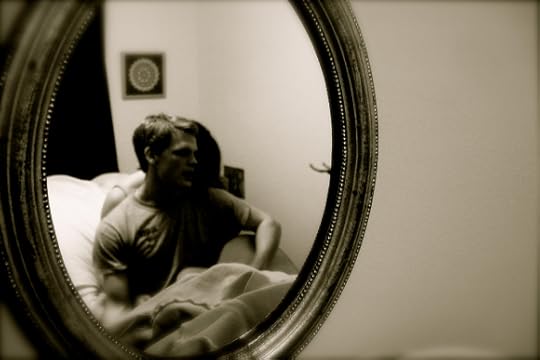Andrew Sullivan's Blog, page 410
December 15, 2013
Carlin’s Catechetics
Hemant Mehta spots this passage from the just-released Conversations with Carlin, in which the late comedian looks back at the childhood religious experiences that helped lead him to atheism:
When you’re seven years old and preparing for your first communion, they tell you a lot of things about how the host is gonna be in your mouth, and it’s the body of Jesus, the body of God, and this will sanctify you, and you’ll feel different. You’ll feel the presence of God. Well, I did my first communion, and I went back to my pew, and I didn’t notice any of that. I noticed this wafer and I’m trying to be reverent, but it wasn’t transformative. So I noticed that. I think in retrospect, it began to make me a little less willing to just jump on everything they said and take the ride. I think I thought that there was an awful lot of exaggeration going on — an awful lot of fanciful talk and magic that they were trying to evoke. And they were always talking about pain and punishment and penance and suffering, and to me, that just didn’t fit. Somehow – and I said this on an early album — they were pushing for pain, and I was pulling for pleasure.
There were times when I still did what some people do who don’t believe well. You find some comfort in it. I would pray for something I wanted, and I would pray if I was scared, because it was a reflex. It was something I had learned, and it made me feel better. I think what that is when we do that is, we’re praying to ourselves — to our better selves. Some call it a higher self. I think the universe is all of us, and when we externalize this thing and call it God, it’s really a way of projecting ourselves onto another identity — onto our better, higher selves that pretty much know everything they need to know, and everything that’s good. So I think praying is all about finding that part of yourself. They call it God. It’s easier to organize people politically, and get them to believe a lot of other things, if you have them believing in an invisible man.



A Poem For Sunday
As mentioned yesterday, this weekend we’re featuring poems from debut collections of poetry. Below is “Beginning of Trust” from Waiting for Saint Brendan and Other Poems by David McLoghlin, published by the Irish press Salmon Poetry:
I’ve forgotten for how long now
I have fallen asleep
knowing you’ll be there tomorrow.
It influences even the way I breathe
and rest into dreams.
And I’m here,
listening to you breathe beside me
in the night light:
I’m here, looking at you,
amazed at your trust
in sleep, in love, in me.
I want to wake you
and tell you what has happened.
(From Waiting for Saint Brendan and Other Poems © 2012 by David McLoghlin. Reprinted with kind permission of Salmon Poetry. Photo by Peter Smida)



Quote For The Day
“There is no need to traverse earth and sky to find a wondrous object full of contrasts of infinite greatness and littleness, of deep gloom and amazing brightness, capable at the same time of arousing piety, wonder, scorn, and terror. I have only to contemplate myself; man comes from nothing, passes through time, and disappears forever in the bosom of God. He is seen but for a moment wandering on the verge of two abysses, and then is lost.
If man were wholly ignorant of himself he would have no poetry in him, for one cannot describe what one does not conceive. If he saw himself clearly, his imagination would remain idle and would have nothing to add to the picture. But the nature of man is sufficiently revealed for him to know something of himself and sufficiently veiled to leave much in impenetrable darkness, a darkness in which he ever gropes, forever in vain, trying to understand himself,” – Alexis de Tocqueville, Democracy in America.



A Bike’s Life
In the short film seen above, Chris McCoy and Adam Neustadter offer a whimsical look at mortality from the perspective of a bicycle. Scott Myers interviewed the duo:
Scott: What was the genesis of this project?
Chris: The original germ of the idea came from the fact that my bike kept getting stolen, and then I began hallucinating that I was seeing it around Los Angeles. I’d see a bike whiz by, I’d momentarily go that’s my bike!, and then I’d realize that it was not my bike and I was suffering from bicycle PTSD or something. I started thinking about what might have happened to my bike after it was taken, which was an idea I ended up discussing with Adam. We’d both wanted to work on something together for a long time, and telling the story of an inanimate object – and humanizing that object, making you feel sympathy for it – felt like an interesting challenge. So we began working on the script. …
Scott: Why give the Protagonist (the bicycle) an English accent?
Chris: There is actually quite a logical reason for the Bicycle having an English accent – the bicycle we used is a Raleigh, which are famously made in Nottingham, England. So of course it would have an English accent. It would be preposterous for it not to.
Adam: We also liked the implied backstory it gave the bike. How did this old British bicycle end up in Venice Beach? You know he must have had some hard miles to get to where we meet him.



How The Nativity Scene Was Born
We have St. Francis to thank for the humble crèche:
The only historical account we have of Francis’ nativity scene comes from The Life of St. Francis of Assisi by St. Bonaventure, a Franciscan monk who was born five years before Francis’ death. According to Bonaventure’s biography, St. Francis got permission from Pope Honorious III to set up a manger with hay and two live animals – an ox and an ass – in a cave in the Italian village of Grecio. He then invited the villagers to come gaze upon the scene while he preached about “the babe of Bethlehem.”
Francis’ display came in the middle of a period when mystery or miracle plays were a popular form of entertainment and education for European laypeople. These plays, originally performed in churches and later performed in town squares, re-enacted Bible stories in vernacular languages. Since church services at the time were performed only in Latin, which virtually no one understood, miracle plays were the only way for laypeople to learn scripture. Francis’ nativity scene used the same method of visual display to help locals understand and emotionally engage with Christianity. Within a couple of centuries of Francis’ inaugural display [in 1223], nativity scenes had spread throughout Europe.
A reader sent the above photo:
Don’t know if this would qualify for a Face of the Day or not, but I figured you’d appreciate this one. This elderly beagle has the run of the neighborhood. I came upon him in this cozy spot in a neighbor’s yard.



Mental Health Break
One of those fancy nature timelapses, best viewed in full screen:
Into The Atmosphere from Michael Shainblum on Vimeo.
Living in California all my life, I had as much time as I needed to really capture the essence and beauty it provides. This video was an ongoing project for about a year with an estimated 75,000 images taken, and about 12,400 made it into the 3.5 minute piece. My Grandmother Alice Harpin passed away during the last two weeks of shooting this video. The film is dedicated to her memory.



Calling Life Into Question
Ferris Jabr explains how he’s come to the conclusion that “life does not actually exist”:
Why is defining life so frustratingly difficult? Why have scientists and philosophers failed for centuries to find a specific physical property or set of properties that clearly separates the living from the inanimate? Because such a property does not exist. Life is a concept that we invented. On the most fundamental level, all matter that exists is an arrangement of atoms and their constituent particles. These arrangements fall onto an immense spectrum of complexity, from a single hydrogen atom to something as intricate as a brain. In trying to define life, we have drawn a line at an arbitrary level of complexity and declared that everything above that border is alive and everything below it is not. In truth, this division does not exist outside the mind. There is no threshold at which a collection of atoms suddenly becomes alive, no categorical distinction between the living and inanimate, no Frankensteinian spark. We have failed to define life because there was never anything to define in the first place.
Jabr isn’t alone in this line of thinking:
I nervously explained these ideas to [Scripps Research Institute researcher Gerald] Joyce on the phone, anticipating that he would laugh and tell me they were absurd. After all, this is someone who helped NASA define life. But Joyce said the argument that life is a concept is “perfect.” He agrees that the mission to define life is, in some ways, futile. The working definition was really just a linguistic convenience. “We were trying to help NASA find extraterrestrial life,” he says. “We couldn’t use the word ‘life’ in every paragraph and not define it.”
Carol Cleland, a philosopher at the University of Colorado Boulder who has spent years researching attempts to deliniate life, also thinks that the instinct to precisely define life is misguided—but she is not yet ready to deny life’s physical reality. “It’s just as premature to reach the conclusion that there is no intrinsic nature to life as it is to define life,” she says. “I think the best attitude is to treat what are normally taken as the definitive criteria of life as tentative criteria.”



Faces Of The Day
For his series Generations, photographer Julian Germain captures 4 or 5 generations in one family portrait. Writing in 2005, Tom Shakespeare praised Germain’s work:
Photography captures a single moment in time. But the work of Julian Germain succeeds in raising questions about time passing which bring together past, future and present within the single image. He has succeeded in using portraiture to explore the particular and the specific in a way that eloquently poses questions about the life of every viewer, sending us away moved and challenged. His work explores not just the individual lifespan from birth to death, but also the context of family and society, which gives meaning to personal stories.
(Photo by Julian Germain)



Should Atheists Be Transhumanists?
Controversial novelist Zoltan Istvan argues in the affirmative, asserting that “atheist voices and their writings have paved the way” for the age of transhumanism. He defines “the core of transhumanist thought”:
It begins with discontent about the humdrum status quo of human life and our frail, terminal human bodies. It is followed by an awe-inspiring vision of what can be done to improve both — of how dramatically the world and our species can be transformed via science and technology. Transhumanists want more guarantees than just death, consumerism, and offspring. Much more. They want to be better, smarter, stronger — perhaps even perfect and immortal if science can make them that way. Most transhumanists believe it can. … If you don’t care about or believe in God, and you want the best of the human spirit to raise the world to new heights using science, technology, and reason, then you are a transhumanist.
Peter Lawler nods, writing that “what Ishtan says makes some sense”:
It seems to me, however, that a philosopher today would still be on firm ground in thinking that transhumanist hope of particular persons around today is no more reasonable that the Christian hope for personal salvation. From that view, transhumanism isn’t really so atheistic. The hope is that we can transform ourselves into the functional equivalent of gods.
Brendan Foht isn’t convinced that atheism and transhumanism are naturally linked:
Istvan is certainly right that transhumanists are motivated by a sense of disappointment with human nature and the limitations it imposes on our aspirations. He’s also right that transhumanists are very optimistic about what science and technology can do to transform human nature. But what do these propositions have to do with atheism? Many atheists like to proclaim themselves to be “secular humanists” whose beliefs are guided by the rejection of the idea that human beings need anything beyond humanity (usually they mean revelation from the divine) to live decent, happy, and ethical lives. As for the idea that we cannot be happy without some belief in eternal life (either technological immortality on earth or in the afterlife), it seems that today’s atheists might well follow the teachings of Epicurus, often considered an early atheist, who argued that reason and natural science support the the idea that “death is nothing to us.”
Previous Dish on transhumanism here, here, and here.



Bertrand Russell’s Brand Of Unbelief
Despite the philosopher’s reputation as a staunch unbeliever, Clare Carlisle argues that he walked the line between atheism and agnosticism:
[T]he same intellectual integrity that made Russell unable to accept religious beliefs also prevented him from embracing atheism. Rather like the 18th-century Scottish philosopher David Hume, Russell maintained a sceptical attitude to metaphysical questions. He explains this position very clearly in a 1953 essay on his agnosticism, where he states that, “it is impossible, or at least impossible at the present time, to know the truth in matters such as God and the future life with which Christianity and other religions are concerned.” …
Although Russell often seems in his writings to be drawn towards a quasi-atheist position, his own agnosticism is reinforced by his recognition that the word “religion” does not have a very definite meaning. “If it means a system of dogma regarded as unquestionably true,” he writes, “it is incompatible with the scientific spirit, which refuses to accept matters of fact without evidence, and also holds that complete certainty is hardly ever attainable.” The agnosticism article was published at a time when critics of religion were often assumed to be communists; Russell counters this suggestion by pointing out that the kind of communism advocated by the Soviet government fits his definition of dogmatic religion, and that therefore “every genuine agnostic must be opposed to it”. It is clear that a passionate aversion to dogmatism runs through both his critique of religious oppression and moralism, and his more positive doctrine of philosophical agnosticism. Russell sometimes seems to be moving towards the view that how ones believes, and not just what one believes, is ethically significant – a view that will be embraced by any reflective religious person.
Previous Dish on Russell here, here, and here.



Andrew Sullivan's Blog
- Andrew Sullivan's profile
- 154 followers






